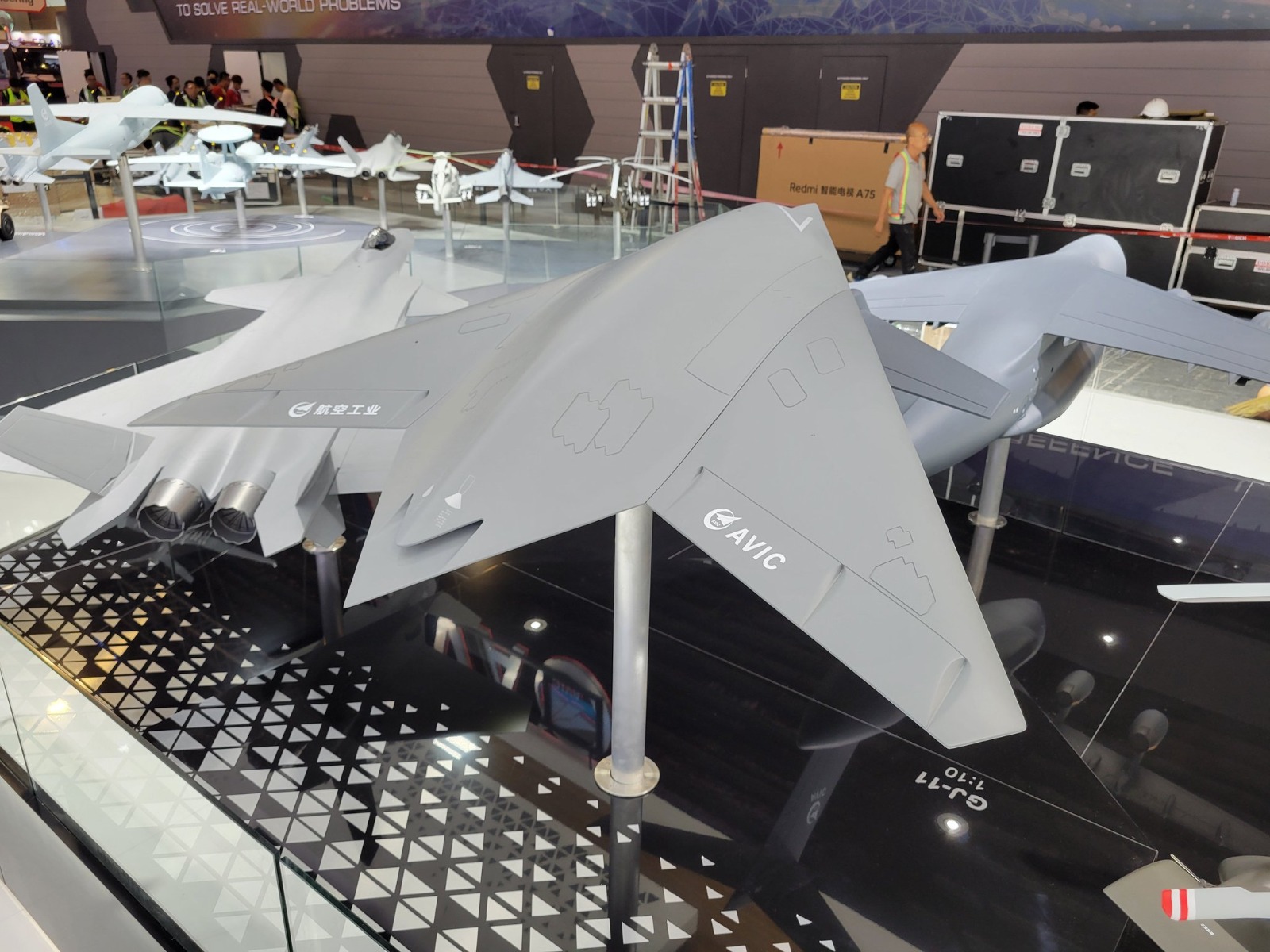On June 14, the internet was abuzz with mockup images of China’s advanced GJ-11 Sharp Sword unmanned combat aerial vehicle (UCAV) at a training site on Changxing Island in Shanghai.
The images, captured via satellite, depict two green-colored UCAVs resembling the GJ-11, strategically placed on a newly constructed apron-like area. Satellite imagery shows a recently built expansive apron at the location, measuring about 405 feet long and 200 feet wide.
This area is accompanied by three distinct structures, one of which appears to be a jet blast deflector. That suggests preparations for flight operations.
Of particular interest is the proximity of these mockups to the construction site of China’s newest amphibious warship, tentatively known as the Type 076.
The Type 076, described as a landing helicopter dock (LHD), is set to feature a significantly large flight deck capable of supporting fixed-wing flight operations through electromagnetic catapults, also called EMALS (electromagnetic aircraft launch system), and arresting gear.

This positions the Type 076 as a potential CATOBAR (Catapult Assisted Take-Off But Arrested Recovery) carrier, a rarity among amphibious assault ships worldwide.
Experts speculate that through these new efforts, China aims to simulate the operational environment for GJ-11 unmanned combat aerial vehicles aboard its future Type 076 landing helicopter dock.
Previous reports suggested that the Type 076 could accommodate a fleet of unmanned aerial vehicles (UAVs), including the GJ-11 UCAV, first showcased during China’s 70th anniversary National Day parade in 2019.
Despite these developments, analysts point out discrepancies in size between the apron on Changxing Island and Type 076’s projected deck dimensions.
Not far from the Zhonghua Shipyard on Changxing Island, a facility that looked like a drone base appeared. On a black parking pad, there were also two green GJ-11 like mockups. There was no runway , but were wide taxiways and apron-like areas on the ground. pic.twitter.com/eexySR0VtS
— Q (@foolsball) June 14, 2024
The Type 076 is expected to measure approximately 864 feet long and 141 feet wide. This presents the challenges in directly correlating the mockup site to the ship’s capabilities.
Nonetheless, the emergence of these images has intensified global interest in China’s evolving naval capabilities, particularly its integration of advanced UAV technology into its maritime strategies.
GJ-11 Unmanned Combat Aerial Vehicle
The GJ-11 unmanned combat aerial vehicle (UCAV) was unveiled during China’s October 2019 military parade, marking the 70th anniversary of the People’s Republic of China.
Developed by the Aviation Industry Corporation of China (AVIC), initial images showed the drone mounted on a truck, offering top and side views. Earlier photographs from 2013 depicted a version with a larger top air intake and a conical exhaust nozzle, contrasting with subsequent models.
At the September 2021 air show in China, a scale model revealed the GJ-11’s distinctive features, including two internal belly weapons bays positioned between side landing gears. Each bay was observed to house four precision-guided air-to-ground glide bombs, hinting at its versatile combat capabilities beyond what was displayed.
According to Chinese military aviation expert Zhang Xuefeng, the GJ-11 boasts a flying wing design with high stealth characteristics and subsonic cruising capabilities bolstered by an extended operational range.
Further, narrators during the past parade broadcast highlighted its primary role in conducting deep-penetration strikes against critical targets, aligning with its designation “GJ,” derived from the Chinese word “gonji,” meaning ‘attack.’

Speculation has been widespread about the GJ-11’s integration into the Chinese Navy, especially regarding its potential deployment on aircraft carriers and large amphibious assault ships. Latest satellite images showing mockups of the drone on Changxing Island add weight to these speculations, suggesting preparations for its inclusion in future naval aviation wings.
Evidence has surfaced in the past suggesting the GJ-11’s future integration into naval operations. In December 2023, Chinese military aviation expert Andreas Rupprecht shared a photograph revealing a land-based mock aircraft carrier facility in Wuhan.
This facility featured replicas of various aircraft, including the J-15, J-35/J-31/FC-31 Gyrfalcon, KJ-600, and, notably, a GJ-11 positioned on the flight deck.

This sighting led People’s Liberation Army (PLA) expert Rick Joe to assert as a “near confirmation” that a “flying wing UAV/UCAV is intended for carrier aviation,” suggesting that the GJ-11 could already be undergoing operational testing.
Another potential role for the GJ-11 involves operating with the J-20 stealth fighter as part of a manned-unmanned teaming concept.
Screenshots from an October 2022 digital representation aired on China Central Television (CCTV) depicted J-20s and H-6K strategic bombers controlling drones as wingmen, specifically identified as GJ-11s in the video.
These instances underscore ongoing developments and speculation surrounding the GJ-11’s versatility and strategic importance within China’s military modernization efforts, particularly in enhancing aerial capabilities through unmanned systems and integrated operations.
- Contact the author at ashishmichel(at)gmail.com
- Follow EurAsian Times on Google News




